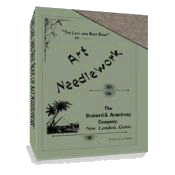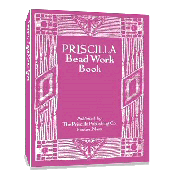Victorian Christmas Decorations
Part 3
Victorian Christmas Decorations, Part 3 is a continuance of an article published in Cassell's household guide: being a complete encyclopaedia of domestic and social economy and forming a guide to every department of practical life, dated (1869) giving advice on how to decorate the Church and home for the Christmas season.
Victorian Christmas Decorations for
the Church and Home
Continued:
Some of the designs already illustrated are suitable for house decorations, especially for large halls at Christmastime. The texts on calico, framed in evergreen wreaths, are particularly suitable, and also such words as " Peace and Good Will towards Men," "Come unto me. all ye that labour," "Welcome," "Glory to God," &c.

If there is a gallery to the church, it may be ornamented by tying garlands of evergreens close together on a rope with twine, so as to form a cordon. Fasten it along the front of the gallery in regular festoons, with a shield over the hollow of each festoon. A set of banners (such as Fig. 15, above), bearing the Christian attributes, Faith, Hope, Charity, Perseverance, Piety, Long-suffering, Love to God, Forbearance. Prayer, Praise, Humility, Sympathy, &c., could be very effectively used. Standard gaslights should be dressed with moderate sized bouquets of holly and berries. The columns should be wreathed with cordons of evergreen.
The decorations of churches should be in keeping with the architecture. Rich carved work should not be touched, but blank spaces covered. A font that has not a carved cover may be enriched with a flat top, decorated with flowers in clay. The Late Pointed style of architecture, as it is called, which has columns with shafts marked by flutes, large windows near together, and screen-work, is best ornamented with shields, monograms, and small ornaments frequently placed. The columns should not be wreathed.
Plain columns may have garlands of flowers round the capitals and base, with or without wreaths all down them. The mere circle round the capitals of columns and the display of texts on the bare walls, suits the heavy Norman architecture best. The Early Pointed style is very well decorated with geometrical combinations of ornament.
To obtain the shape of a shield, first draw a heart on paper, making it rather long for the width; afterwards rule a straight the across the top, marking above the semicircles. The shield shape is thus constructed. Shields may be suspended by coloured ribbon below the capitals of columns, the capitals having wreaths of evergreen round them.

Fig. 3 is an illustration of the decoration of church pillars. The two styles shown in A and B should not be mixed in one church. A is decorated with a double wreath at the top, and a shield hung on the column by means of ribbon or coloured tape. B is an evergreen cordon. If the decoration B is used, then between the arches shields may be placed in the manner shown, suspended by a ribbon with a triple bow. A nail must be fixed in the wall, to which a bunch of evergreens can be tied, The shield is hung over this by the ribbon from a second nail higher up, and the ribbon passed behind the bouquet of evergreens.

Fig. 2 is gallery decoration. Banners, or circles, or devices in evergreen, may take the place of shields in the way shown in Fig. 1, shown below. The cross is made of yellow flowers, the circle of black flowers, and there is a white eye in the centre. Such devices may be alternate with twisted festoons or smaller festoons, or they may only occur three times in the length of the gallery, according to taste and resources. There should be a handsome device for the organ gallery, if there be one; a large text in flowers at least. Where an organ gallery exists, it should always display one of the best ornaments made for the church.

To decorate a schoolroom or hall for Christmas, make a cordon of evergreens on a rope. Fix nails close to the ceiling at regular intervals, and suspend the cordon in festoons. Make hoops of crinoline cane, which cost a halfpenny each, as large as a family tea-tray. Hang these on the walls at intervals, after they have been covered with evergreens. Cut a number of pieces of scarlet, blue, and yellow silk or glazed calico, like banner hand-screens. Take a sheet of gold paper, pencil letters on the back, and cut them out. With these form sentences on the banners, such as "A Merry Christmas," "Welcome," "Be Merry and Wise," "Peace and Good Will." Cut fringe from the gold paper and edge the banners. Cut cane the length of the top, gum the top of the banner over the cane, and fix pink tape ends to hang it from the wall, as the shields are hung in Fig. 1. A banner is to be placed in the centre of each hoop.
The cordon of flowers round the top of the wall will be improved by a few crimson and pink paper flowers, sewn on at intervals. To make these, fold in strips a sheet of tissue paper; trace a tea-saucer on it, and cut out the round from the doubled paper. Crimp the paper with a reader's knife. About six rounds, sewn together in the centre at the back and pinched into shape, make the rose. At the principal end of the room let the cordon from the ceiling form a double festoon, with white calico between the loops, on which an appropriate sentence or motto is inscribed.
Pieces of crinoline cane, or lath, tied across and covered with evergreen bound on with twine, make good crosses for church decoration.
To make texts of cut-out letters, paper, silk, cloth, or velvet may be used. The initial letter of every word may be large and of one colour, the other letters small and black, or of another colour. Or alternate colours may be used for the words. Wall-paper offers a good ground for texts. Red cloth paper, as a ground, may have on it blue, gold, and black letters. Blue cloth paper — gold, scarlet, green, and silver letters. Pale green — scarlet, gold, and violet letters. Violet — red, gold, silver, and black.
Suitable papers and substances for text grounds are morocco paper, paper imitating straw plait, fancy wood, mother-of-pearl, and papers with small gold patterns on them. These fancy papers can be had of most fancy stationers, and the wall-papers from paperhangers.
To make the crosses and circles correctly, a box of instruments is needed — one that includes a compass, a rule, and a bow-pencil. A box lid, if quite even, may be substituted for a rule. A bow-pencil can be improvised by taking a drawing-pin or a packing-needle and tying a string to it. Stick it well in the paper. Measure the distance for the size of the circle, and tie the other end of the string to the pencil. Then carry the pencil all round on the paper at the full length of the string. Drawing-pins also serve to fix texts in many parts of a church. They may be inserted all round like borders, and they do not damage woodwork, which is a recommendation for their use.
Paste all the letters to be used in forming a text at the back, and lay them on a clean newspaper. Do not put more paste than necessary. Fix on one at a time, pressing it with a clean soft rag or handkerchief—so as to absorb and remove any superfluous moisture — or a few sheets of blotting paper. To make the paste, take three tablespoonfuls of flour, and as much powdered rosin as will lie on a shilling, Mix nicely in half a pint of water, and then stir it over the fire in a saucepan till it boils. Boil it for five minutes. Use cold. It will not keep long. The paste-brush must be cleansed in boiling water, and wiped every time it is used.
In mediaeval times the following significance was given to colour: — White was emblematical of light, purity, virginity, faith, joy, and life. Carmine red, of Christ's passion and death, of royalty, of the Holy Spirit, and of fire. Blue, of truth, constancy, piety. Dark red, of anger, war, and bloodshed. Gold and bright yellow, of the sun, of brightness, marriage, and fruitfulness. Dingy yellow, of deceit and jealousy. Green, of hope, of spring, prosperity, victory, immortality. Violet, of love, truth, humility, passion, and suffering. Black, of death, mourning, humiliation; also of the earth. Blue with gold stars, of heaven. White and red roses, of love and innocence, or love and wisdom.
For more information, see:
The beginning of this article, go to Victorian Christmas Decorations for the Church and Home.
For Part 2 of this article, go to Victorian Christmas Decorations for the Church and Home, Part 2.
And for decorations specifically for the home, see Victorian Household Christmas Decorations.
Return to top of Victorian Christmas Decorations, Part 3 page.
Return to Victorian Christmas page.
The Last and Best Book of Art Needlework
Over 100 pages of authentic Victorian instructions and patterns from 1895!
FREE
Beeton's Book Of Needlework

433 pages!
Sign up for VEAC! Everything you wanted to know about Victorian embroidery, needlework, crafts and more!
Priscilla Bead Work Book
Make Beautiful Victorian Beaded Purses, Jewelry & Accessories - Starting
TODAY!



